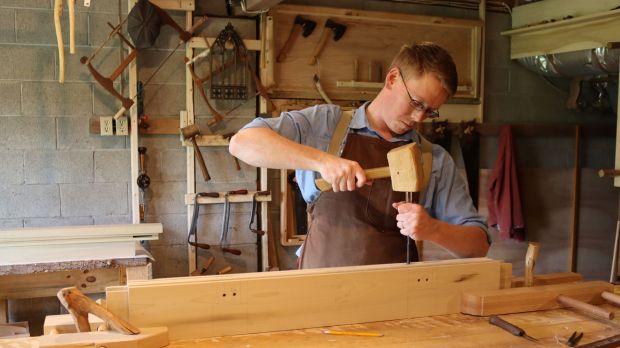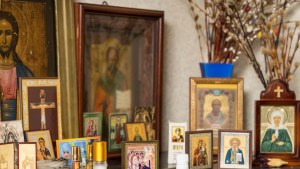Lenten Campaign 2025
This content is free of charge, as are all our articles.
Support us with a donation that is tax-deductible and enable us to continue to reach millions of readers.
The ultimate desires of the human person are for truth, beauty and goodness—and for the God who is all three. The pursuit of these transcendentals brings meaning and abiding joy to our lives. But far too often, these are in short supply—even in the Church, which should be at the vanguard of sharing them with our culture.
The good news is that there’s a growing movement of Catholics committed to restoring and reviving beauty in the Church. One of these is a woodworking family, Wesley and Kelly Baker of Contrasts Woodcarving. They specialize in making traditional Gothic and Romanesque ecclesiastical woodwork.
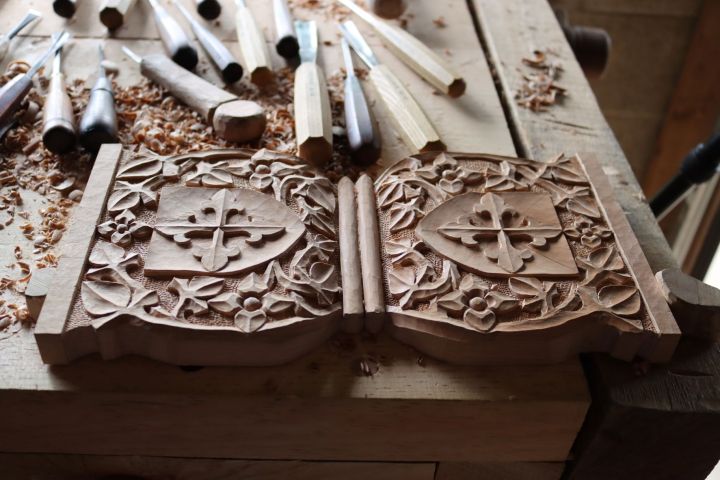
Their work “is an effort to restore or provide beauty to churches that have lost it, or never had it in the first place,” Wesley Baker said in an interview with Aleteia. They are commissioned to create entirely new pieces as well as historic restorations.
A family apostolate
Contrasts Woodcarving is truly a family business. They have no employees and do all the work themselves, often with the help of their five (soon to be six) children. The work is almost entirely done by hand in each phase: the drafts, the joinery, the carving, and the finishing.
“Not only do we prefer to work this way, we are convinced that there is a distinctiveness, vivacity and warmth of the human touch that just can’t be found in machine-made, mass-production. To us, and to our clients, this seems more than fitting for the house of God, Who, so far from repetitive mass production, willed that each individual snowflake should be entirely unique.”

Wesley and Kelly met in college and converted to Catholicism after two years of marriage in 2009, the same year that their child was born. At first, woodworking was just one of many endeavors they dabbled in: They raised livestock on a small homestead, taught RCIA classes, and gave talks to parishes and retreats. They called their work Sancta Familia Apostolate.
But they really wanted to focus their efforts on ecclesiastical woodwork, and their big break came in 2015. “I was commissioned to design and build a new set of furniture for a chapel—altar, reredos, communion rail, lectern, and credence,” Baker said.
He jumped at the opportunity, even though he wasn’t totally sure he was up to the task. But it turned out well. His customers loved it and spread the word about his work. Priests began to reach out to the Bakers about commissions, and their business as Contrasts Woodcarving grew quickly.
In imitation of the Holy Family
The Bakers see their work as part of a “broader work of restoration and rejuvenation that is a perennial part of the life of the Church.” It quickly became clear to them that their part in that restoration was ecclesiastical woodwork.
Among many other reasons, they have a strong devotion to the Holy Family of Nazareth: “We have tried to adopt some of the externals of their way of life in hopes of developing some of the internal peace and virtue of that Home,” Baker said. It’s wonderfully appropriate, then, that he does the same kind of work that St. Joseph and Jesus themselves once did.
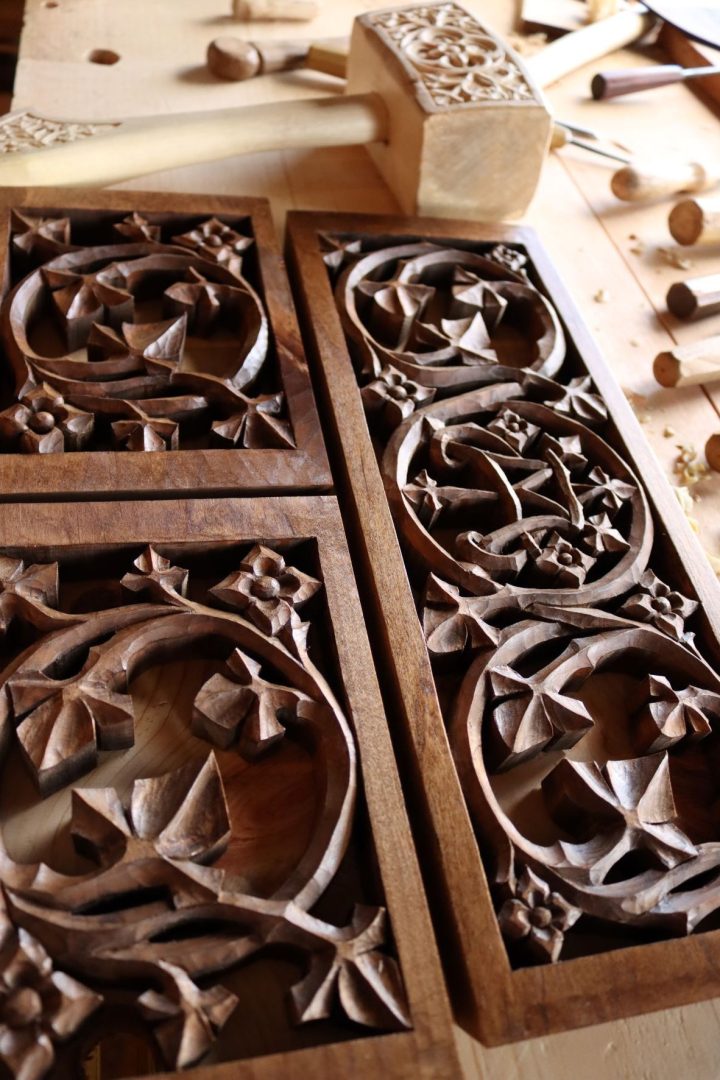
His shop is in the basement of their home, allowing the family to be together for meals and frequent visits. “I get to be there for my family and they get to see me sacrificing for them, earning our bread by the sweat of my brow,” he said. At the same time, “I get a window into the sacrifices my wife is making for me and for our children. And this awareness of the sacrifices we both make fosters deeper love and commitment between us.”
Baker has worked on a number of incredible projects over the years—a 10-foot-tall votive shrine to the Sorrowful Mother, for example, with much larger projects in the works—but one of the most meaningful was something smaller: restoring a simple communion rail.
His work put it back into use after years of collecting dust in an attic of the rectory. The communion rail was in his shop for a long time, and Baker found great meaning in working on it.
“I often thought about all the loving souls who received Our Lord in Communion at that rail—the poor Irish and German immigrants who had sacrificed so much to build this beautiful church and this rail, which was original to the building. The fact that I was entrusted with the task of making it usable again was truly humbling.”
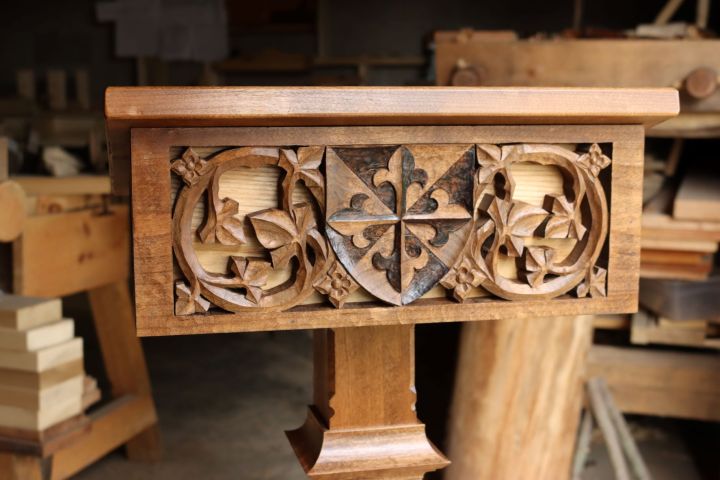
That communion rail is a fitting emblem of a vocation that centers on the Holy Mass and the sacraments. “We see our small role in restoring beauty and reverence as a part of a revival of a truly Catholic culture, which, if it is to be authentic, must be centered on the liturgy and draw its strength and vigor from the sacraments,” Baker said.
To explain why this restoration is so important, Baker quoted Catholic writer Hillaire Belloc:
“There is (as the greatest of the ancient Greeks discovered) a certain indissoluble Trinity of Truth, Beauty, and Goodness. You cannot deny or attack one of these three without at the same time denying or attacking both of the others … There is coming not only a contempt for beauty but a hatred of it; and immediately upon the heels of this there appears a contempt and hatred for virtue.” (The Great Heresies, 1938)
Certainly there is a lot of good work being done in the Church today to teach the Truth and to encourage folks to Goodness, that is, to become saints. “But there is not nearly enough being done to restore and defend authentic Beauty,” Baker said. Because of this inattention to Beauty, “efforts being made in the other two areas are being undermined. The three are mutually dependent.”
The Bakers’ mission to defend Beauty is threefold. They are committed to restoring reverence not only for the Holy Mass but also for human work and for beautiful art.
1Reverence for the Holy Sacrifice of the Mass
“If that is really God, how ought we to build and adorn our churches? If that is really the renewal of the propitiatory Sacrifice of God on Calvary, how ought we to celebrate and assist at the liturgy? … It is our hope that creating or restoring an atmosphere of beauty in our churches will help to convey the unfathomable treasure of the Mass, and of the other sacraments which are directed to the Blessed Sacrament as to their end.”
2Reverence for human work
“Humans are unique composites of bodies and souls and both ought to be engaged in proper, human work … We live in a digital age of virtual realities where the average person’s work is not tangible, is not involved in this creative process of using the matter brought into existence by the Creator, Who, in turn, invited the first man to join Him in the ongoing work of creation, when He invited him to till the garden and to keep it. There is something rich and profound in this human work. Those of us who are engaged in it tend to find ourselves infatuated. It’s not just a job that we perform to get a paycheck. It’s much more than that—it becomes part of who we are. We are constantly growing in our craft, constantly studying and reviving and mastering the art we practice. This passion for the work makes a difference in the finished product.”
3Reverence for art as a channel of beauty
“The modern perspective tends to see art predominantly as a form of self-expression … In the Middle Ages, the artist saw himself as a public servant. He saw his work not as a means of self-expression, but as a means of ennobling society, of elevating the souls of those who would see his work. I am convinced, for the good of the Church and of the world, we need to revive this traditional perspective on art and this traditional role of the artist in society.”
Ultimately, Contrasts Woodcarving is not only a family business but also a true apostolate. “We would very much appreciate prayers for the success and expansion of this work,” Baker said. Our hopes and prayers accompany their work, which is so valuable in the Church and the world.

